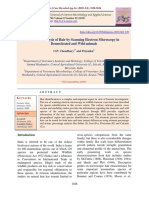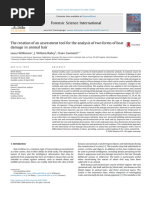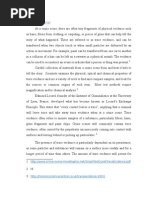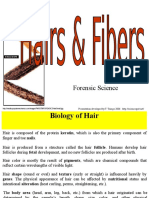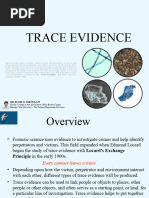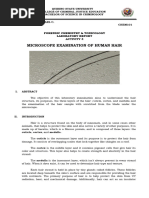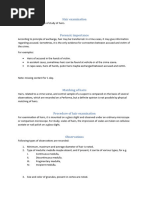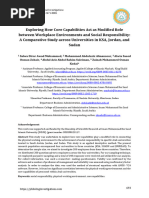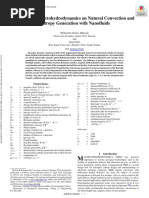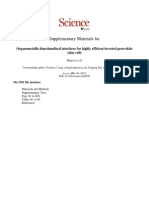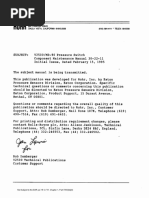Science Citation Index journal
Science Citation Index journal
Uploaded by
p.maheswariopenventioCopyright:
Available Formats
Science Citation Index journal
Science Citation Index journal
Uploaded by
p.maheswariopenventioCopyright
Available Formats
Share this document
Did you find this document useful?
Is this content inappropriate?
Copyright:
Available Formats
Science Citation Index journal
Science Citation Index journal
Uploaded by
p.maheswariopenventioCopyright:
Available Formats
Journal of Science and Technology
ISSN: 2456-5660 Volume 06, Issue 05, SEP-OCT 2021
www.jst.org.in DOI: https://doi.org/10.46243/jst.2021.v6.i05.pp01-06
REVIEW ON FORENSIC ANALYSIS OF HAIR BY SCANNING ELECTRON
MICROSCOPE IN DOMESTIC AND WILD ANIMALS
Gurleen kaur1, Komaljeet Kaur1*, Haritha S 2 ,Chandana deka3
1
Research Scholar, Department of Forensic Science, Chandigarh University, Punjab
1*
Research Scholar, Department of Forensic Science, Chandigarh University, Punjab
2
MSc. Student, Department of Forensic Science, Chandigarh University, Punjab
3
Research Scholar, Department of Forensic Science, Chandigarh University, Punjab
Email : gurleen2597@gmail.com
To Cite this Article
Gurleen kaur, Komaljeet Kaur, Haritha S ,Chandana deka, “REVIEW ON FORENSIC ANALYSIS OF
HAIR BY SCANNING ELECTRON MICROSCOPE IN DOMESTIC AND WILD ANIMALS”, Journal
of Science and Technology, Vol. 06, Issue 05, Sep-Oct 2021, pp01-06.
Article Info
Received: 02.09.21 Revised: 05.09.21 Accepted: 09.09.2021 Published: 14.09.2021
ABSTRACT
Analysis and Identification of hair is the most complex and distinct aspect in the field of
forensics.The examination of animal hair is a ubiquitous discipline in wildlife forensics.
Examination is largely based on microscopy, which enables the hair analyst in identification
of hair as animal in origin, to distinguish the hair to a particular species, and to conduct
comparative examinations. Analysis of animal remains, e.g. hair at a crime scene helps to
provide evidence for contact of a suspected assailant and diagnosing drug expose. The
cuticular pattern, cross section and medullary index provides information on the domestic and
wild species of the animal. The present study was conducted to investigate some
morphological features of hair samples of domesticated and wild animal species using
scanning electron microscopy for their identification. Scanning Electron Microscope shows
the optical means of identification regarding structural, surface morphology, coupled with
scientific data and focuses on species identification.
INTRODUCTION
Illegal poaching is a challenge to a wide variety of endangered species worldwide[1].It has en
dangered wildlife, ecosystems, lives, and livelihoods, in equal measure, in both developing
and developed world nations.It has changed dimensions and scale in a way that suits an incre
asingly digitized world that has seen personal and materialistic boundaries blur.Wildlife crim
es frequently occur in remote areas without witnesses, leaving wardens with very little eviden
ce to investigate.A seemingly perfect crime disguises a series of clues that are invisible to the
average eye that need to be strategically placed together to solve the crime.WildlifeForensics
use the same standards as human forensics, with a few variations. The difference is that wildli
fe forensics need to be able to identify and differentiate between a variety of species, whereas
human forensics includes only one species homo sapiens.Modern crime detection has becom
e a scientific endeavor that involves testing, evaluating and recognizing biological evidence, f
ingerprints, blood and skin traces, tissue samples, teeth pulp, hair to establish the nature of th
Published by: Longman Publishers www.jst.org.in 1 | Page
Journal of Science and Technology
ISSN: 2456-5660 Volume 06, Issue 05, SEP-OCT 2021
www.jst.org.in DOI: https://doi.org/10.46243/jst.2021.v6.i05.pp01-06
e crime and the method of execution and, most importantly, the perpetrator of the crime..Acc
ording to wildlife protection act, 1972 ‘wildlife’includes any animal, aquatic or land
vegetation which forms part of any habitat.
The killing of wild animals which are beingprotected from hunting by legislation, also know
as poaching, is one of the most serious crimes investigated by forensic wildlife scientists. Oth
er wildlife crimes include the purchase and sale of endangered animals, and the possession an
d sale of protected animals. [2,3]Wildlife forensic is one of the fields of forensic science that
involve the use of scientific procedures to examine, identify and compare the evidences from
crime scene .The purpose of this is to link the suspect with the victim (which is specifically
ananimal)[4].Forensic wildlife scientists must be prepared to recognise samples from any spec
ies in the world that are illegally hunted, stolen, poached or traded in an illicit market.Althoug
h wildlife forensic scientists may seem to be facing a daunting challenge in developing new a
nd accurate identification techniques, they have one advantage over human forensics-
sample size is rarely a problem.The mammalian hair fibres depict a compelling biological
material which can be sampled, collected, transported and resist putrefaction which remains
for very long periodof time, therefore which makes it feasible for providing long-term
information. In some cases, hair samples can be the only evidence recovered from a crime
scene. The hair morphology is useful for the study of evolution and domestication of various
mammals in zoology, morphology, archeological studies and forensic sciences.The macro
and microscopical structural features are widely used for identification of hair and for
proceeding the investigation. Microscopic analysis remains principally qualitative technique
including visual assessments and signifies on developing more objective metrics and even
less on quantitation of hair damage extremity. Thespecific features of the hair shaft (ratio of
development of three layers, cuticle, cortex and medulla) and their structures which is
discussed in figure 1 pigmentation of cortex, cuticular pattern, shape of cuticular scalesand
the shape, size, pigmentation and position of medullar cells. Scanning Electron Microscope
(SEM) is considered to be the most preferred method for identification and analyzation of
internal features of hair samples.
METHOD
Search Action
A coordinated and methodized search was conducted for articles related to particular topic
includes collection of hair from crime scene, structure of hair, analyzation of hair using
scanning electron microscope and forensic significance of hair. Preliminary investigation in
Google Scholar gave up auxiliary unique results with respect to particular topic therefore, the
investigation of journal was restricted to PubMed, Web of science and Research Gate.
Study Selection
The search results from the database gave back 67 articles from PubMed. A supplementary
55 journal reports and articles were received from Web of Science and 112 from Research
Gate, pertinent to the study criteria. These contents were analyzed independently.234 articles
were included for the study and 67 were removed due to their insignificance to the pertained
topic. The complete texts of 73 articles were scrutinized for inclusion and 83 were rejected in
final scrutiny, by reason of reiteration of information. 11 journal report from the initial search
action were used in the study selection.
Published by: Longman Publishers www.jst.org.in 2 | Page
Journal of Science and Technology
ISSN: 2456-5660 Volume 06, Issue 05, SEP-OCT 2021
www.jst.org.in DOI: https://doi.org/10.46243/jst.2021.v6.i05.pp01-06
Collection of hair
The hair samples from various regions of animal body, poaching surroundings and from
regions surrounding the dead animal body is taken using forceps. Gloves should be used
during collection process in order to avoid contamination of evidences. The collected hair and
other evidences are packed in zip lock bags and then transferred to a paper envelope. The hair
samples are preserved by washing them with absolute alcohol at room temperature for about
24 hours and are packed in fresh zip lock bags. The preserved hair sample is kept in 4°Ctill
further analysis. The sample should be properly cleansed to remove excess dirt or dust
particles for obtaining accurate result during analysis.
SCANNING ELECTRON MICROSCOPE [10]
The Scanning Electron Microscope (SEM) scans a focused electron beam over a surface to
create an image.The hair samples can be dissected in pieces of 5mm sizeleaving 3 mm from
root side with the help of stereomicroscope. The sample holder with mounted samples are
coated with gold using auto fine coater and are observed under a Scanning Electron
Microscope for the aspect of better and prominent result.
Analyzation using SEM provides accurate details of hair sample such as scale count, scale
structure, scale height, hair shape, hair diameter and surface damage, whether physical or
chemical at variable magnifications. Elemental analysis of hairscan be done by using Energy
Dispersive Spectrum (EDS) coupled with SEM for analysis of different elements of periodic
table.The animal hair variability in each race is greater than the variability of hairs on a single
individual’s head. Supporting the statement of(J.Curr.Microbiol.App.Sci(2019) 8(2): 1028-
1034) the hair of the cat is nearly circular in cross-sections ,coarser and straighter hair (which
is discussed in figure 3) and antelope hair is the roost flattened being quite curly in nature, as
tends to be the case with flattened ovaloid cross-sectioned hair(discussed in figure 2).
In SEM, stereo photographs can be taken which provides better magnification of the sample.
Stereo photographs are taken by placing the sample at a particular angle,then tilting it an
additional 2° to 10° to another angle for taking another picture. It is the angle at which the
sample can be normally observed and depth is interpreted by analysing the images formed at
the different angles. The stereo image can be observed by holding the picture about 10 inches
from the eyes, and views the stereo pair. Stereo glasses can also be used to view the image.
Stereo photographs show the depth of field which cannot be observed under normal light
optical instruments as the depth of field would not be the same and shows poor resolution
with the optical instruments in general use.
Published by: Longman Publishers www.jst.org.in 3 | Page
Journal of Science and Technology
ISSN: 2456-5660 Volume 06, Issue 05, SEP-OCT 2021
www.jst.org.in DOI: https://doi.org/10.46243/jst.2021.v6.i05.pp01-06
Figure 2 showing wild Antelope hair under scanning electron microscope
Figure 3 showing domestic cat hair under SEM
FORENSIC SIGNIFICANCE
Hair is an eclectic integrant in forensic science and an indispensable feature in the process of
investigations. Animal hair is one of the most ubiquitous aspect in the field of wildlife
forensic. In forensic, morphological examination of hair is the pre-eminent process during
hair examination. The major medico legal concerns associated with hair examination includes
species identification,origin of the particular species, determination of the hair’s origin from
the body and the comparison of the hair sample from the victim to the crime scene. It is an
illustrious information that from morphological features of hairs, animal species can be
discriminated without further unpleasant concerns which provides the pathway for
Published by: Longman Publishers www.jst.org.in 4 | Page
Journal of Science and Technology
ISSN: 2456-5660 Volume 06, Issue 05, SEP-OCT 2021
www.jst.org.in DOI: https://doi.org/10.46243/jst.2021.v6.i05.pp01-06
morphological examination of hairs as an important method used in forensic science. The
major features that make hair a good subject for establishing identity of an individual are its
resistance to chemical decomposition and its ability to retain structural features over long
period of time. Cuticle has a major role in providing resistance to the hair.The peculiar
differencesin the hair including pathological, chemical and other abnormal conditions which
affects the structural and surface characteristics of hair helps in identifying the animal
individuals.
DISCUSSION
The purpose of present study was to establish a detailed knowledge on the aspects of
peculiarity of hair samples in the field of wildlife forensic.Significance of hair in forensic, its
collection and preservation methods, structural characteristics of hair and its analyzation
using scanning electron microscope. Scanning electron microscope is an advanced technique
for sample analysis and provides a clear-cut view on the sample placed. Species identification
and determining the origin of species was a challenging factor once but with the advanced
technologies it seems elementary nowadays. Scanning Electron Microscope is one of the
major equipment used in hair analysis due to its high resolution and magnification power. It
is mainly used for species identification by examining the cuticular pattern, cross section and
medullary index of the hair. Species determination provides details on the origin and
characteristic of a particular animal individual.
CONCLUSION
Wildlife forensic is a combined version of various field of science in accordance with wildlife
protection and conservation act. Hair identification is an involuted and distinct aspect in view
of forensic investigation.It entails several tests and uncertainties still exist in determining
conclusions to establish whether a single hair is identifiable from an individual. The
Scanning Electron Microscope alone may not provide final conclusions, as however, with
farther tests and comparative studies, this type of study eventually leads toa more
constructive identification of the hairs, since it definitely shows improvement over the optical
means of identification regarding structural, surface morphology, coupled with other
scientific data.
REFERENCES
1. Kumar Jha, D., Kumar Gupta, S., Kshetry, N. T., Panday , R., & Pokharel, B. R.
(2017). A Pioneer Case Study on Identification of Infant Rhinoceros Horn. Journal of
Forensic Research, 08(02).
2. Retrieved from http://cpreec.org/32.htm
3. Retrived from http://legislative.gov.in/sites/default/files/A1972-53_0.pdf
4. Retrived from https://www.encyclopedia.com/science/encyclopedias-almanacs-
transcripts-and-maps/wildlife-forensics
5. Deedrick DW, Koch SL (2004). Microscopy of hair Part I: A practical guide and
manual for human hairs. J. Forensic Sci. Comm. 6(1): 1-50.
6. Dobb MG, Johnston FR, Nott JA, Oster I, Sikorski J, Simpon WS (1996).
Morphology of the cuticle layer in wool fibres and other animal hairs. J. Text. Inst.
52: 153-170.
Published by: Longman Publishers www.jst.org.in 5 | Page
Journal of Science and Technology
ISSN: 2456-5660 Volume 06, Issue 05, SEP-OCT 2021
www.jst.org.in DOI: https://doi.org/10.46243/jst.2021.v6.i05.pp01-06
7. Farag MR, Abou-Hadeed AH, Ghoniem MH, Alagawany M, Laudadio V, Tufarelli
V (2015). Chemical composition and mineral contents differentiation in hairs of
some wild animal species. Pak. J. Zool. 47(4): 1189-1191.
8. Farah S, Tsach T, Bentall A, Domb AJ (2014). Morphological, spectral and
chromatography analysis and forensic comparison of PET fibers. Talanta. 123: 54–
62.
9. Gaudette BD (1999). Comparison significance of hair evidence. Identification of
human and animal hair. Encyclopedia of forensic science, hair academic press, San
Diego. 3: 999-1041.
10. Hess WM, J erran TF, Clyde LP, James VA (1985). Characterization of hair
morphology in families tayassuidae and suidae with scanning electron microscopy.J.
Mammal. 66(1): 75-84.
11. Inagaki H, Tsukahara T (1993). A method of identifying chimpanzee hairs in lion
faeces. J. Primates. 34(1): 233-235.
12. Jones LN, Horr TJ, Kaplin IJ (2001). Formation of surface membranes in developing
mammalian hair fibre. J. Micron. 25: 589-595.
13. Jones LN, Rivett DE (1997). e role of 18-methyle icosanoic acid in the structure
and formation of mammalian hair fibres. Micron. 28: 469-485.
Published by: Longman Publishers www.jst.org.in 6 | Page
You might also like
- Demag DKUN Hoist Operating ManualDocument80 pagesDemag DKUN Hoist Operating ManualCraneMaintain81% (27)
- O.P. Choudhary and PriyankaDocument7 pagesO.P. Choudhary and PriyankaDiary ThalitaNo ratings yet
- Analysis of Hair Samples Using Microscopical and MDocument7 pagesAnalysis of Hair Samples Using Microscopical and MPrajogo KusumaNo ratings yet
- Forensic TrichologyDocument5 pagesForensic TrichologyeferrarijrNo ratings yet
- Experiment 3 FrsDocument10 pagesExperiment 3 FrsWanMohammadHajidi100% (2)
- Ghallab 06072018 ProofDocument8 pagesGhallab 06072018 Proofpuneetlamoria05No ratings yet
- 33 Hair and Fiber AnalysisDocument9 pages33 Hair and Fiber AnalysisUthara Bhavani NairNo ratings yet
- ขนสัตว์ถูกทำลายด้วยความร้อนDocument19 pagesขนสัตว์ถูกทำลายด้วยความร้อนtrkrteeNo ratings yet
- Astudy of Variations in Some Morphological Features of Human HairDocument6 pagesAstudy of Variations in Some Morphological Features of Human HairNinadNagraleNo ratings yet
- Forensic Human Hair Examination GuidelinesDocument32 pagesForensic Human Hair Examination GuidelinessbspuNo ratings yet
- Annotated Bibliography HairDocument21 pagesAnnotated Bibliography HairEdward Arthur IskandarNo ratings yet
- A Study On Hair Analysis of Different Canidae BreedsDocument8 pagesA Study On Hair Analysis of Different Canidae BreedsAgnieszka DaszczyńskaNo ratings yet
- Forensic EvidenceDocument36 pagesForensic EvidenceBryan MagcantaNo ratings yet
- Paper MayadaDocument11 pagesPaper MayadaАлина ГрачеваNo ratings yet
- Using Microscopy To Determine If Canine Breeds Can Be Identified For Forensic Purposes Bruerton, J. (2012), UnpublishedDocument1 pageUsing Microscopy To Determine If Canine Breeds Can Be Identified For Forensic Purposes Bruerton, J. (2012), UnpublishedJB5391No ratings yet
- Week 11 Powerpoint SLP Forensic ChemistryDocument52 pagesWeek 11 Powerpoint SLP Forensic ChemistrySheena De Guzman MorenoNo ratings yet
- Spectroscopy and chemometrics for differentiation of sex in humanDocument5 pagesSpectroscopy and chemometrics for differentiation of sex in humanRuben_Monroy_ClaudioNo ratings yet
- Project of ForensicDocument23 pagesProject of ForensicTAMANNANo ratings yet
- UrineDocument11 pagesUrineShubham PatwaNo ratings yet
- Trace Evidence LectureDocument9 pagesTrace Evidence Lecturejovelynromero42No ratings yet
- Under The Microscope Class 9 and 10 Hair AnalysisDocument4 pagesUnder The Microscope Class 9 and 10 Hair AnalysisJainam ChowhanNo ratings yet
- Module 6 HAIR AND FIBER PDFDocument14 pagesModule 6 HAIR AND FIBER PDFLaurence Airand CadienteNo ratings yet
- Hairs and FibresDocument2 pagesHairs and Fibresapi-32133818No ratings yet
- Pubic Hairs Were Collected From 27 Volunteers Employed in The Department of Forensic Biology at The Office of Chief Medical Examiner in New York CityDocument2 pagesPubic Hairs Were Collected From 27 Volunteers Employed in The Department of Forensic Biology at The Office of Chief Medical Examiner in New York CityshintasissyNo ratings yet
- Lesson 17 - Hair EvidenceDocument25 pagesLesson 17 - Hair Evidencejaxplays20No ratings yet
- Forensic Science Chapter 3 The Study of Hair NotesDocument55 pagesForensic Science Chapter 3 The Study of Hair Notes6n5f6rgg9pNo ratings yet
- Hair A Good Source of Dna To Solve The CrimeDocument10 pagesHair A Good Source of Dna To Solve The Crimejaiharini03No ratings yet
- Endangered Bird Species Classification Using Machine Learning TechniquesDocument10 pagesEndangered Bird Species Classification Using Machine Learning TechniquesIJRASETPublicationsNo ratings yet
- Borbon PeTa #6Document3 pagesBorbon PeTa #6Borbon, Raphael Juan Jacinto O.No ratings yet
- The Microfollicle - A Model of The Human Hair FollicleDocument12 pagesThe Microfollicle - A Model of The Human Hair FollicleMietekNo ratings yet
- Taphonomy of Hair A Study of PostmortemDocument8 pagesTaphonomy of Hair A Study of PostmortemRegulus Fidelis SevillaNo ratings yet
- Docsity Webquest Hair AnalysisDocument3 pagesDocsity Webquest Hair Analysiscjclark921No ratings yet
- Spatial and Environmental Variation of The Human Hair MicrobiotaDocument7 pagesSpatial and Environmental Variation of The Human Hair MicrobiotaSimony SilvaNo ratings yet
- Hairs and FibersDocument16 pagesHairs and Fibersapi-262815720No ratings yet
- Application of Differential Scanning Calorimetry in Hair SamplesDocument4 pagesApplication of Differential Scanning Calorimetry in Hair SamplesGustavo Christian Quintino da SilvaNo ratings yet
- Trace EvidenceDocument45 pagesTrace EvidenceRONAN CLYVE CUETONo ratings yet
- Ajvr-Ajvr 23 12 0293Document7 pagesAjvr-Ajvr 23 12 0293viviana castilloNo ratings yet
- Chapter12 ForensicsDocument31 pagesChapter12 ForensicsMohamed Ali AbdiNo ratings yet
- Forensic Hair AnalysisDocument31 pagesForensic Hair AnalysisJauhar FirdausNo ratings yet
- Journals AnatomyDocument12 pagesJournals AnatomyHesti HariantiNo ratings yet
- FHDFDocument7 pagesFHDFLilacx ButterflyNo ratings yet
- Hairs and FibersDocument19 pagesHairs and FibersSanstubNo ratings yet
- Human Hair Morphology - A Scanning Electron Microscopy Study On ADocument13 pagesHuman Hair Morphology - A Scanning Electron Microscopy Study On AGamer LoverNo ratings yet
- Lab Report 3 Chem101Document2 pagesLab Report 3 Chem101Chelsea Pearl C. SabadoNo ratings yet
- Lab Report 4 Chem101Document2 pagesLab Report 4 Chem101Chelsea Pearl C. SabadoNo ratings yet
- Comparative Study of Different Microscope in ForensicDocument9 pagesComparative Study of Different Microscope in Forensicshahabsayed189No ratings yet
- Fin Irjmets1667640963Document7 pagesFin Irjmets1667640963toleraabdisa098No ratings yet
- Shrestha Et Al 2015 Prevalence Domesticated Mange Katmandu PDFDocument6 pagesShrestha Et Al 2015 Prevalence Domesticated Mange Katmandu PDFjulian satriaNo ratings yet
- Emc - Module8 Fore FCTDocument35 pagesEmc - Module8 Fore FCTpunitpuwit18No ratings yet
- Forensic Examination of Animal HairDocument16 pagesForensic Examination of Animal HairNatasyaNo ratings yet
- Analysis of Hair Using Microscopic and Molecular Techniques To Ascertain Personal IdentificationDocument27 pagesAnalysis of Hair Using Microscopic and Molecular Techniques To Ascertain Personal IdentificationBijay KarkiNo ratings yet
- Hairs and Fibers 20Document20 pagesHairs and Fibers 20jenny lazaroNo ratings yet
- Animal Models of Brain TumorsDocument390 pagesAnimal Models of Brain TumorsJaime BarralNo ratings yet
- Substitute IvoryDocument8 pagesSubstitute IvoryVipin SharmaNo ratings yet
- Part I-PIDocument30 pagesPart I-PIRicojohn ManimtimNo ratings yet
- Hair ExaminationDocument2 pagesHair ExaminationYash GuptaNo ratings yet
- U2C12P2 Identification Comparison Collection and Preservation of Hair 2Document28 pagesU2C12P2 Identification Comparison Collection and Preservation of Hair 2miangdong24No ratings yet
- Age Estimation Based On Appearance of GrayDocument5 pagesAge Estimation Based On Appearance of GrayghiffarifariNo ratings yet
- Premature Graying As A Consequence of Compromised Antioxidant Activity in Hair Bulb Melanocytes and Their PrecursorsDocument8 pagesPremature Graying As A Consequence of Compromised Antioxidant Activity in Hair Bulb Melanocytes and Their PrecursorsTiurma SibaraniNo ratings yet
- Chapter 5Document5 pagesChapter 5Alyssa CancejoNo ratings yet
- Computer Science JournalsDocument6 pagesComputer Science Journalsp.maheswariopenventioNo ratings yet
- Cutting-Edge ScienceDocument5 pagesCutting-Edge Sciencep.maheswariopenventioNo ratings yet
- 1_13481171580Document9 pages1_13481171580p.maheswariopenventioNo ratings yet
- Emerging trends in scienceDocument10 pagesEmerging trends in sciencep.maheswariopenventioNo ratings yet
- Machine Learning applicationDocument6 pagesMachine Learning applicationp.maheswariopenventioNo ratings yet
- Advances in AstrophysicsDocument7 pagesAdvances in Astrophysicsp.maheswariopenventioNo ratings yet
- Advances in AstrophysicsDocument5 pagesAdvances in Astrophysicsp.maheswariopenventioNo ratings yet
- Machine Learning applicationDocument9 pagesMachine Learning applicationp.maheswariopenventioNo ratings yet
- Technology integrationDocument7 pagesTechnology integrationp.maheswariopenventioNo ratings yet
- Machine Learning applicationDocument9 pagesMachine Learning applicationp.maheswariopenventioNo ratings yet
- Economic and Cultural GrowthDocument10 pagesEconomic and Cultural Growthp.maheswariopenventioNo ratings yet
- Interdisciplinary researchDocument12 pagesInterdisciplinary researchp.maheswariopenventioNo ratings yet
- Ethical AI PracticesDocument8 pagesEthical AI Practicesp.maheswariopenventioNo ratings yet
- Technology integrationDocument9 pagesTechnology integrationp.maheswariopenventioNo ratings yet
- Technology integrationDocument22 pagesTechnology integrationp.maheswariopenventioNo ratings yet
- Machine Learning applicationDocument3 pagesMachine Learning applicationp.maheswariopenventioNo ratings yet
- Emerging trends in scienceDocument10 pagesEmerging trends in sciencep.maheswariopenventioNo ratings yet
- Scientific discoveriesDocument5 pagesScientific discoveriesp.maheswariopenventioNo ratings yet
- Emerging trends in scienceDocument20 pagesEmerging trends in sciencep.maheswariopenventioNo ratings yet
- Scientific discoveriesDocument5 pagesScientific discoveriesp.maheswariopenventioNo ratings yet
- Scientific discoveriesDocument17 pagesScientific discoveriesp.maheswariopenventioNo ratings yet
- Technological AdvancementsDocument10 pagesTechnological Advancementsp.maheswariopenventioNo ratings yet
- Scientific collaborationDocument6 pagesScientific collaborationp.maheswariopenventioNo ratings yet
- Research and DevelopmentDocument3 pagesResearch and Developmentp.maheswariopenventioNo ratings yet
- Science and Technology HealthDocument6 pagesScience and Technology Healthp.maheswariopenventioNo ratings yet
- Interdisciplinary StudiesDocument12 pagesInterdisciplinary Studiesp.maheswariopenventioNo ratings yet
- Dat - FL040C MM T eDocument2 pagesDat - FL040C MM T eTC LinNo ratings yet
- Abbassi (2018) Effects of Magnetohydrodynamics On Natural Convection and Entropy Generation With NanofluidsDocument13 pagesAbbassi (2018) Effects of Magnetohydrodynamics On Natural Convection and Entropy Generation With NanofluidsNoor ZebNo ratings yet
- 2022/03/28 Hydraulic TankDocument3 pages2022/03/28 Hydraulic TankLuis Lossio GuayamaNo ratings yet
- Basic Electrical Engineering McqsDocument103 pagesBasic Electrical Engineering Mcqsyogs patelNo ratings yet
- Science - Abm8566 SMDocument51 pagesScience - Abm8566 SMBhabaniNo ratings yet
- (PDF) Geology For Civil Engineers (Second Edition) - NAIYAR IMAM - Academia - EduDocument182 pages(PDF) Geology For Civil Engineers (Second Edition) - NAIYAR IMAM - Academia - EduSangin ZandiNo ratings yet
- Module 1 The Nature of MathematicsDocument83 pagesModule 1 The Nature of MathematicsEunice LiquidoNo ratings yet
- 1 Introduction To Eurocodes - 2011Document24 pages1 Introduction To Eurocodes - 2011susan87No ratings yet
- Certikin Gas HeaterDocument2 pagesCertikin Gas HeaterRAKESH REDDYNo ratings yet
- Formula CheatsheetDocument1 pageFormula CheatsheetGABRIEL LOUIS GUANONo ratings yet
- Tallent Pro Major Test 1 P 1+2 (A) +2 Nurture Jee Main 08.07.2024 f1Document13 pagesTallent Pro Major Test 1 P 1+2 (A) +2 Nurture Jee Main 08.07.2024 f1Aman GuptaNo ratings yet
- College of Teacher Education: F = m g = ρ V gDocument5 pagesCollege of Teacher Education: F = m g = ρ V gAgyao Yam FaithNo ratings yet
- Five Star GroutDocument2 pagesFive Star GroutCHIMA ikechukwuNo ratings yet
- Research Questions: Experiment No. 4Document1 pageResearch Questions: Experiment No. 4FujiNo ratings yet
- The Design of An Annular Combustion Chamber: October 2017Document11 pagesThe Design of An Annular Combustion Chamber: October 2017ko koNo ratings yet
- Mathematics: Practice Paper 8300Document20 pagesMathematics: Practice Paper 8300• rabia ᡕᠵ᠊ᡃ່࡚ࠢ࠘ ⸝່ࠡࠣ᠊߯᠆ࠣ࠘ᡁࠣ࠘᠊᠊ࠢ࠘ •No ratings yet
- Rohr, Inc.: CHULA VOSTA GALIFORNIA 91910-2098 (B19) 891-4111 ' TELEX: 89-5038Document13 pagesRohr, Inc.: CHULA VOSTA GALIFORNIA 91910-2098 (B19) 891-4111 ' TELEX: 89-5038jordiNo ratings yet
- DLL chemNOV15Document5 pagesDLL chemNOV15Rosallie Caaya-NuezNo ratings yet
- (Journal of Social Ontology) An Introduction To MetametaphysicsDocument4 pages(Journal of Social Ontology) An Introduction To MetametaphysicsABRAHAMNo ratings yet
- MT Level III QuestionsDocument12 pagesMT Level III QuestionsAnu Anoop100% (2)
- Semi-Detailed Lesson Plan in Physics Force, Motion and EnergyDocument7 pagesSemi-Detailed Lesson Plan in Physics Force, Motion and EnergyAly SobosoboNo ratings yet
- Selecting The Most Effective Nudge: Evidence From A Large-Scale Experiment On ImmunizationDocument92 pagesSelecting The Most Effective Nudge: Evidence From A Large-Scale Experiment On ImmunizationPaulo Vitor Antonacci MouraNo ratings yet
- This Section Consists of Four Questions: B1, B2, B3 and B4. Answer Two QuestionsDocument2 pagesThis Section Consists of Four Questions: B1, B2, B3 and B4. Answer Two QuestionsJorge ChavezNo ratings yet
- Hamza Army Public School & College (B0Ys) Mcqs Mathematics Hssc-IiDocument7 pagesHamza Army Public School & College (B0Ys) Mcqs Mathematics Hssc-IiIsbah INo ratings yet
- Maths Key Points 10em-1 PDFDocument17 pagesMaths Key Points 10em-1 PDFsaiNo ratings yet
- Mech 324 - Prelim - Module No 5Document14 pagesMech 324 - Prelim - Module No 5Aomine DaikiNo ratings yet
- STD Xii Physics Ms Set IIDocument8 pagesSTD Xii Physics Ms Set IIRagavNo ratings yet
- Question Formation Indirect QuestionsDocument3 pagesQuestion Formation Indirect QuestionsjanegrsNo ratings yet
- Ronak Sir's - YT Video Links and Lecture NotesDocument298 pagesRonak Sir's - YT Video Links and Lecture Noteslanako8235No ratings yet

